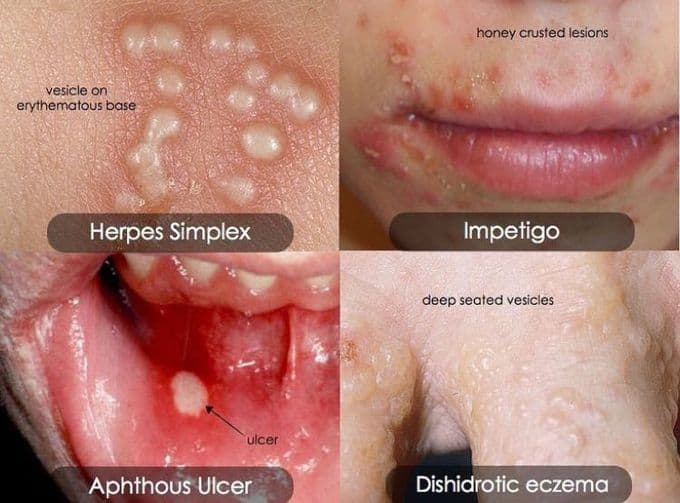Cold Sores vs. Impetigo: Understanding the Differences
Hey there, Super Parents! ? As guardians of health and happiness, we know you’re always on the lookout for what’s best for your little ones. Today, let’s unravel the tangled web of skin concerns and shine a light on two culprits that often mystify parents: cold sores and impetigo. Although they may seem similar at first glance, there are key differences that are oh-so-important to recognize for prompt and effective treatment. So, grab your superhero capes, and let’s zoom into the world of skin health!
What are Cold Sores?
Cold sores, also known as fever blisters, are small, fluid-filled blisters that typically appear on or around the lips. Caused by the herpes simplex virus (HSV), many people are exposed to this virus in childhood, but it can remain dormant for years. Stress, illness, or sun exposure can trigger these unsightly sores, and while they can be uncomfortable and a little embarrassing, they’re usually not a cause for alarm.
What is Impetigo?
On the other hand, impetigo is a highly contagious skin infection caused by bacteria, primarily Staphylococcus aureus or Streptococcus pyogenes. It generally affects children more than adults and is best known for its hallmark red sores that quickly rupture, ooze for a few days, and then form a yellowish-brown crust. Impetigo typically appears on the face, especially around the nose and mouth, but it can spread to other areas through touch, clothing, or towels.
Visual Distinctions: Spot the Differences
- Appearance: Cold sores often start with a tingling sensation and progress to clusters of blisters. Impetigo sores, on contrast, start as red bumps that become blister-like and then crust over.
- Locations: Cold sores are mostly found on the lips and occasionally under the nose or around the chin. Impetigo can start near the nose or mouth but can appear anywhere on the body.
- Contagion: Both are contagious, but impetigo can spread across the body or to other people more easily.
Is It Cold Sores or Impetigo?
Are you looking at a cold sore or a bout of impetigo? The key to telling these two apart lies in close observation and knowing a bit about your child’s prior health history. Consider recent behaviors and exposures, too—has your child recently been in the sun for long periods, which can trigger cold sores? Have there been outbreaks of impetigo at school?
Treating Cold Sores
If your little hero has encountered the cold sore villain, don’t worry! Many cold sores can be addressed with over-the-counter treatments like topical creams and pain-relieving ointments. Staying hydrated, avoiding acidic or spicy foods, and keeping the area clean can help speed up recovery. For recurrent or severe cases, your pediatrician may prescribe antiviral medication.
Treating Impetigo
Impetigo, while daunting, can also be tackled with the right tools. Treatment usually involves prescription antibiotics in the form of ointment or, for more serious infections, oral antibiotics. It’s vital to keep your child’s nails trimmed and clean to avoid spreading the infection, and don’t forget to wash hands thoroughly and often!
Remember, dear parents, each case is unique, and your pediatrician should be your go-to resource for advice on managing these conditions. While this guide provides a handy starting point, professional medical advice is essential for the well-being of your mighty munchkin.
So, now that you’re equipped with knowledge as your superpower, you’re all set to tackle these skin invaders with confidence! Stay vigilant, treasure the health of your young ones, and always keep that smile shining bright! ? The next time you’re faced with cold sores or impetigo, you’ll know exactly what steps to take for your child’s speedy recovery.

5 Things Parents Should Know in Preparing for Cold Sores vs. Impetigo
The realm of parenting requires foresight and preparation, especially when it comes to the health of your fearless explorers. Here are five essential things every parent should know when armouring up against cold sores and impetigo:
1. Early Identification Is Key
Being able to distinguish between cold sores and impetigo at the earliest stage can help expedite treatment and minimize discomfort. Keep an eye on tell-tale signs: the suspicious tingle preceding a cold sore, or the characteristic redness that signals the onset of impetigo.
2. Prevention Strategies
For cold sores, minimize triggers by ensuring your child wears SPF lip balm and avoids extreme weather conditions. In the case of impetigo, prioritize hygiene—frequent handwashing and avoiding sharing of towels or utensils with infected individuals can go a long way.
3. Understanding Contagion Control
Since both conditions are contagious, teach your kiddos good hygiene practices. Encourage them not to pick at sores, which can spread the infection. If one child in the household is affected, take steps to isolate their utensils, bedding, and personal items.
4. Proper Wound Care
Maintaining cleanliness is non-negotiable. Gently cleanse any affected areas with mild soap and water, and apply any prescribed treatments as directed. For impetigo, cover sores with loose gauze to prevent bacterial spread.
5. When to Seek Professional Help
Connect with your pediatrician if you notice any signs of infection, if the sores seem to worsen or spread, or if your child experiences significant discomfort. It’s also essential to follow up with medical care if initial treatments don’t seem to be working after a few days.
Additional Tips for the Super Parent
Beyond the essentials, here are proactive steps to champion your child’s health in the battle against cold sores and impetigo:
- Boost their immune system with a nutritious diet rich in vitamins and minerals. A strong immune system can fend off outbreaks or aid faster recovery.
- Teach children about avoiding close contact or sharing items with peers who have visible sores, without stigmatizing the condition.
- Have a first-aid kit equipped with recommended over-the-counter treatments and a set of clean towels and linens ready to change out frequently.
- Keep some child-friendly, informational books or materials about prevention and care, so they understand why these hygiene practices are important.
- Praise and reward your child for following proper hygiene habits; positive reinforcement can go a long way in establishing lifelong healthy practices.
Equipped with this comprehensive guide and a heart filled with love and concern, you, dear parent, are a force to be reckoned with. Whether it’s the sneaky cold sore or the pesky impetigo, you now have the know-how to protect your little adventurer’s skin and overall well-being. Go forth with this newfound wisdom and share it with fellow parents – after all, knowledge is power, and in this case, the power to heal and comfort.
See more great Things to Do with Kids in New Zealand here. For more information see here
Disclaimer
The articles available via our website provide general information only and we strongly urge readers to exercise caution and conduct their own thorough research and fact-checking. The information presented should not be taken as absolute truth, and, to the maximum extent permitted by law, we will not be held liable for any inaccuracies or errors in the content. It is essential for individuals to independently verify and validate the information before making any decisions or taking any actions based on the articles.




